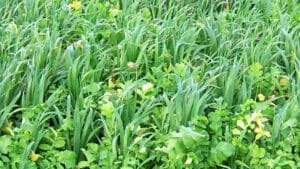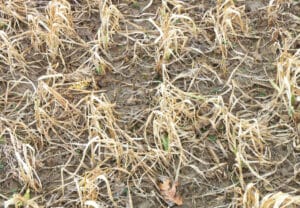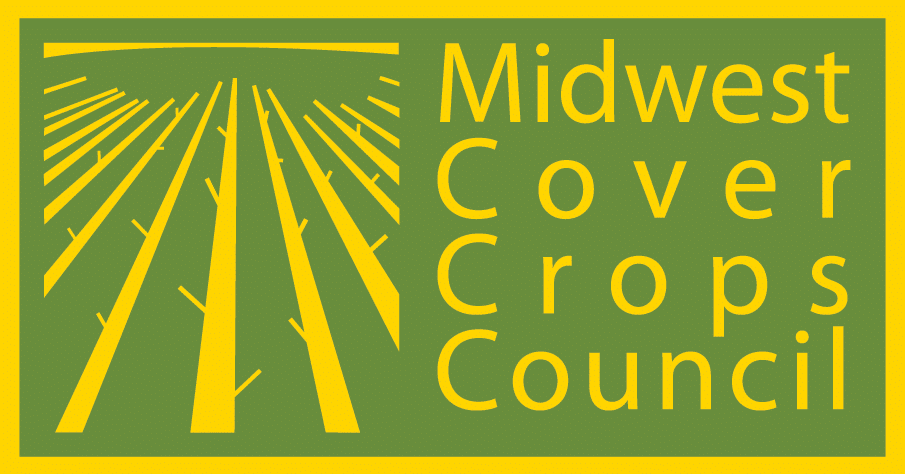Midwest Cover Crops Council (MCCC-101)
Purdue Extension (AY-357-W)
This publication is intended to provide a starting point for farmers who are new to growing cover crops. With experience, farmers may fine-tune the use of cover crops for their systems.
Introduction
The following recipe provides an introductory approach to integrating a cover crop into a soybean-corn rotation. Often the easiest place to begin is to plant a cover crop ahead of a soybean cash crop following corn, so consider starting with the companion recipe titled Post Corn, Going to Soybean (publication MCCC-100/AY-356-W; see Resources).
Planning and Preparation
- Planning—Educate yourself. Start small. Be timely. Prioritize management based on your purpose and objectives.
- Soybean variety and planting—If possible, plant the preceding soybean crop early and use an early maturity soybean cultivar. One strategy is to use your earliest- maturity-group soybeans on the fields where you plan to seed cover crops and plant those beans first.
- Residual soybean herbicides—Because oats are very tolerant of most soybean residual herbicides, few restrictions apply unless grazing is being considered. Radish is more sensitive and will likely be harmed if ALS-type (group 2) or PPO-type (group 14) herbicides are used in the soybean cropping season. (See Resources.)
- Seed purchase—Order cover crop seed early. Named oat varieties grow well but are more expensive than VNS (variety not stated) seed. Start with VNS seed with a good germination rate purchased from a reputable seed dealer. Note that this means the seed has been cleaned, tested for germination, and has a seed tag even though it is VNS. Although usually not less expensive than oat seed, spring barley can be used instead. For cover crop radishes (daikon type), be sure to purchase a single variety from a reputable seed dealer since mixed varieties may bolt or go to seed rather than producing the desired large amounts of biomass and roots.

Fall Work
- Soybean harvest—Harvest fields where a mix of spring oats/radish are to be planted as early as possible.
- Timing of planting—Ideally, plant oats/radish immediately after harvest. In most of Indiana, this should occur by the third week in September. See Selector Tool (in Resources section) for more precise dates for your county.
- Planting method—Drill to a depth of 0.25–0.50 inch or broadcast, but note that incorporation of the seed, if any, should be light since excessive disturbance of soybean stubble may negate any benefit of the cover crop. See Resources for more details on seeding methods.
- Seeding rate in oats/radish mix—Drilled: oats, 30–60 lbs./acre; radish, 2–3 lbs./acre. Broadcast: oats, 35–65 lbs./acre; radish, 3–4 lbs./acre.
- Aerial seeding or overseeding—An alternative to seeding after harvest is to do aerial seeding with a plane or helicopter or overseeding with a ground-based vehicle.In most of Indiana, seeding should take place in late August or by the first week of September and before 25% of the soybean leaves have yellowed and dropped. Rainfall after seeding is essential for establishment.
- Seeding rate for overseeding—For oats: 40–60 lbs./acre; for radish: 3–4 lbs./acre.
- Tillage or no-tillage—To allow for adequate cover crop growth, it is best if no full-width tillage takes place until oats/radish have been killed by freezing temperatures. If tillage is used, it is usually better to wait until spring in order to maintain surface cover to prevent erosion.
- Fertility or liming—If applying P, K, or lime, complete the application prior to the seeding operation or apply to the growing oats/radish before the ground freezes. If it is necessary to inject N fertilizer or manure in the fall, a low-disturbance applicator should be used to minimize reduction in surface residues.
Spring Work
- Starter fertilizer—Strongly consider equipping your corn planter with 2×2 starter fertilizer, and aim for a starter fertilizer rate between 30–50 pounds of actual N per acre.

Resources
Cover Crop Selector Tool — available from the Midwest Cover Crops Council
Post Corn, Going to Soybean: Use Cereal Rye (Indiana Cover Crop Recipe series, MCCC-100/AY-356-W)
Managing Cover Crops: An Introduction to Integrating Cover Crops into a Corn-Soybean Rotation (Purdue Extension publication AY-353-W)
Residual Herbicides and Fall Cover Crop Establishment (Purdue Extension Weed Science publication)
Terminating Cover Crops: Successful Cover Crop Termination with Herbicides (Purdue Extension publication WS-50-W),
Recommended Cover Crop Seeding Methods and Tools (Agronomy Technical Notes)—available from the USDA–Natural Resources Conservation Service
Authors
Eileen Kladivko, Purdue University; Shalamar Armstrong, Purdue University; and Anna Morrow, Midwest Cover Crops Council
Reviewers and Contributors
Marisol Berti, North Dakota State University; Barry Fisher, USDA-NRCS; William Johnson, Purdue University; Tom Kaspar, USDA–Agricultural Research Service (retired); DeAnn Presley, Kansas State University; Vaughn Sothman, Sharp Brothers Seed Co., Kansas; and Anne Verhallen, Ontario Ministry of Agriculture, Food and Rural Affairs
The Midwest Cover Crops Council aims to facilitate widespread adoption of cover crops throughout the Midwest by providing educational/outreach resources and programs, conducting new research, and communicating about cover crops to the public.
Funding for this project was provided by McKnight Foundation.
Revised May 2019
The U.S. Department of Agriculture (USDA) prohibits discrimination in all its programs and activities on the basis of race, color, national origin, age, disability, and where applicable, sex, marital status, familial status, parental status, religion, sexual orientation, genetic information, political beliefs, reprisal, or because all or a part of an individual’s income is derived from any public assistance program. (Not all prohibited bases apply to all programs.) Persons with disabilities who require alternative means for communication of program information (Braille, large print, audiotape, etc.) should contact USDA’s TARGET Center at (202) 720-2600 (voice and TDD). To file a complaint of discrimination write to USDA, Director, Office of Civil Rights, 1400 Independence Avenue, S.W., Washington, D.C. 20250-9410 or call (800) 795-3272 (voice) or (202) 720-6382 (TDD). USDA is an equal opportunity provider and employer. ©2019 by MCCC. All rights reserved.
